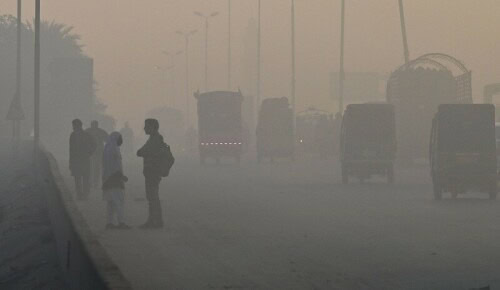Ahmed Bin Ali
With the onset of winter in Pakistan, the country experiences a concerning increase in smog levels. This phenomenon has its roots in several significant factors, with Lahore and Karachi emerging as the most severely affected cities. If Pakistan fails to promptly address climate change, it could exacerbate a wide range of environmental challenges.
Smog, a hazardous form of air pollution, results from a complex interplay of various toxicants and industrial activities. It is primarily attributed to emissions from factories and other industrial sources, but natural factors, such as unfiltered substances released into the atmosphere, can also contribute. Smog, the combination of “smoke” and “fog,” is characterized by its main constituents, including unfiltered oxides, gases, dust, and smoke. These elements, or pollutants, are highly chemically reactive and pose severe health risks to both humans and wildlife.
Lahore, in particular, has grappled with smog-related issues in recent years. As of October 30, 2023, the Air Quality Index (AQI) in the city stood at a perilous 441, signifying hazardous conditions. The consequences of air pollution extend beyond human health, affecting the entire ecosystem. Geographical conditions, global temperature fluctuations, and environmental variations collectively influence human well-being and the overall environment, including the well-being of animals.
Several health issues have been associated with smog. Prolonged exposure to polluted air can trigger asthma, causing airway inflammation and increased mucus production, resulting in breathing difficulties. Elevated air pollution levels, especially with high sulfur dioxide and nitrogen dioxide content, can lead to bronchitis, characterized by inflamed bronchial tube linings, causing breathlessness and persistent coughing with thick mucus.
Exposure to polluted air during pregnancy and early life can weaken immunity in infants, rendering them susceptible to a range of health problems later in life. Smog in Lahore has been associated with an increased risk of leukemia among residents. Leukemia is a cancer of the blood and bone marrow, manifesting with symptoms like bruising, joint and bone pain, bleeding, weight loss, and fever. Various factors, including exposure to radiation and harmful pollutants, family history, and smoking, contribute to this risk.
The presence of various air toxicants in the atmosphere can lead to more frequent and severe health crises, including asphyxiation and death. The PM2.5 concentration in Lahore is currently 49.1 times the WHO annual air quality guideline value. Prevailing winds originating from the north of India and Pakistan have compounded the issue, affecting regions like Lahore, Faisalabad, Okara, and New Delhi.
To make a substantial impact on air quality, it is essential to encourage and, in some cases, require households to install air purifiers. These devices can significantly enhance the air quality indoors by effectively filtering out a wide range of airborne contaminants. By reducing allergens and pollutants, they can help alleviate various allergic symptoms and promote better respiratory health.
In 2022, the Punjab Government enforced Section 144 throughout the province to prohibit the burning of crop residues and garbage, there is a need for strict and sincere implementation.It’s imperative to educate the public not to burn items like plastics, garbage, or painted materials. The combustion of these substances can release toxic chemicals into the air, contributing to air pollution. Moreover, wind can carry the particulate matter from burned trash over a wider area, increasing the scope of the problem. This polluted air poses health risks for both animals and humans.
One of the primary sources of urban air pollution is vehicles that emit black smoke. To combat this issue effectively, it is vital to impose strict regulations and periodic vehicle inspections. Vehicles found emitting black smoke should be promptly taken off the road and undergo maintenance to rectify the problem.
Industrial emissions are another substantial contributor to air pollution. Implement strict regulations and enforcement for industrial facilities to reduce their emissions. Encourage the use of cleaner technologies and continuous monitoring to ensure compliance. Incorporate more green spaces and urban planning that prioritizes environmental sustainability. Trees and plants can help absorb pollutants and improve overall air quality
An informed and conscientious public is key to making these changes effective. Public awareness campaigns should be launched to educate citizens about the consequences of poor air quality and the role they can play in reducing pollution. Providing information on the health risks associated with air pollution and offering practical solutions can encourage individuals to take action. Encourage the use of sustainable and environmentally friendly modes of transportation, such as public transit, cycling, and electric vehicles.
In light of the rising AQI, it is advisable for everyone to wear masks and stay indoors to minimize exposure to smog. As winter progresses, there is a concern that the AQI may continue to rise, posing more significant challenges in the coming weeks.
The increasing threat of smog in Pakistan demands immediate attention and a comprehensive strategy to combat air pollution, safeguard public health, and protect the environment. Each year, we encounter the same problem, and it seems to worsen with each passing year.
Ahmed Bin Ali is a student of A levels at Aitchison College, Lahore














